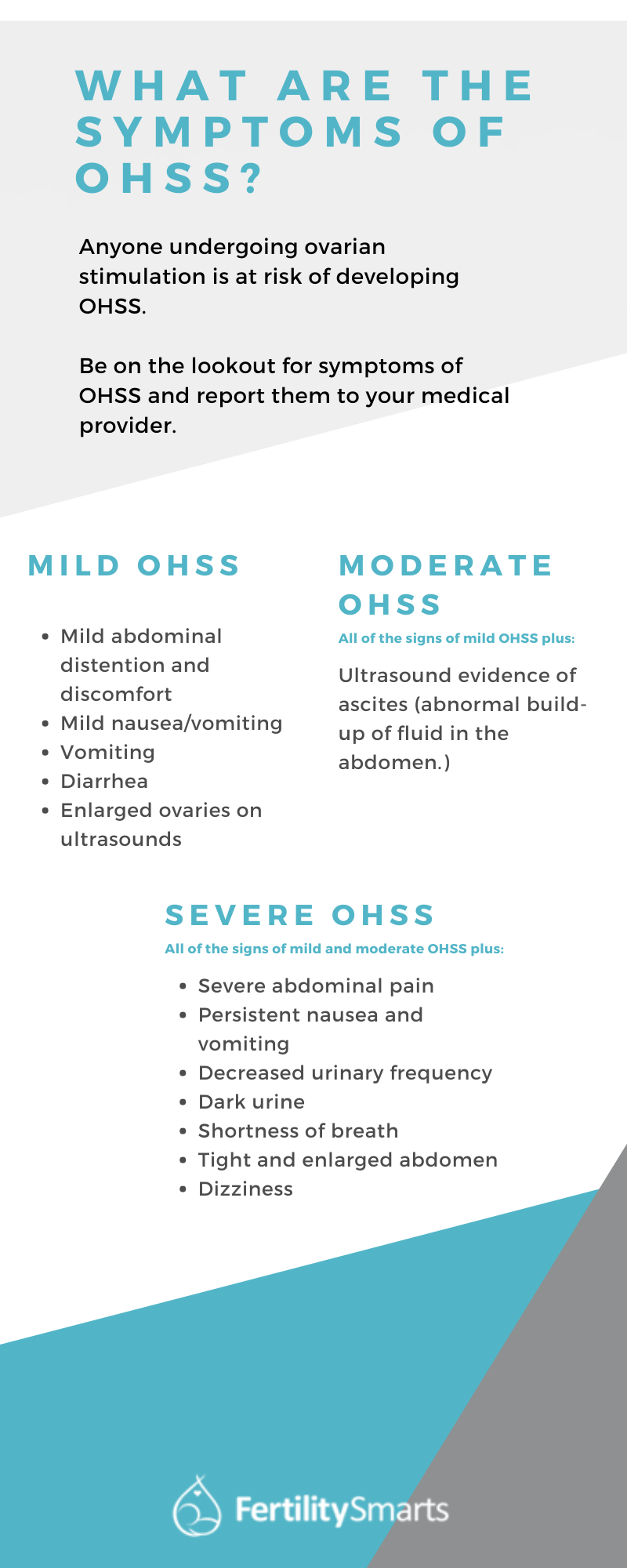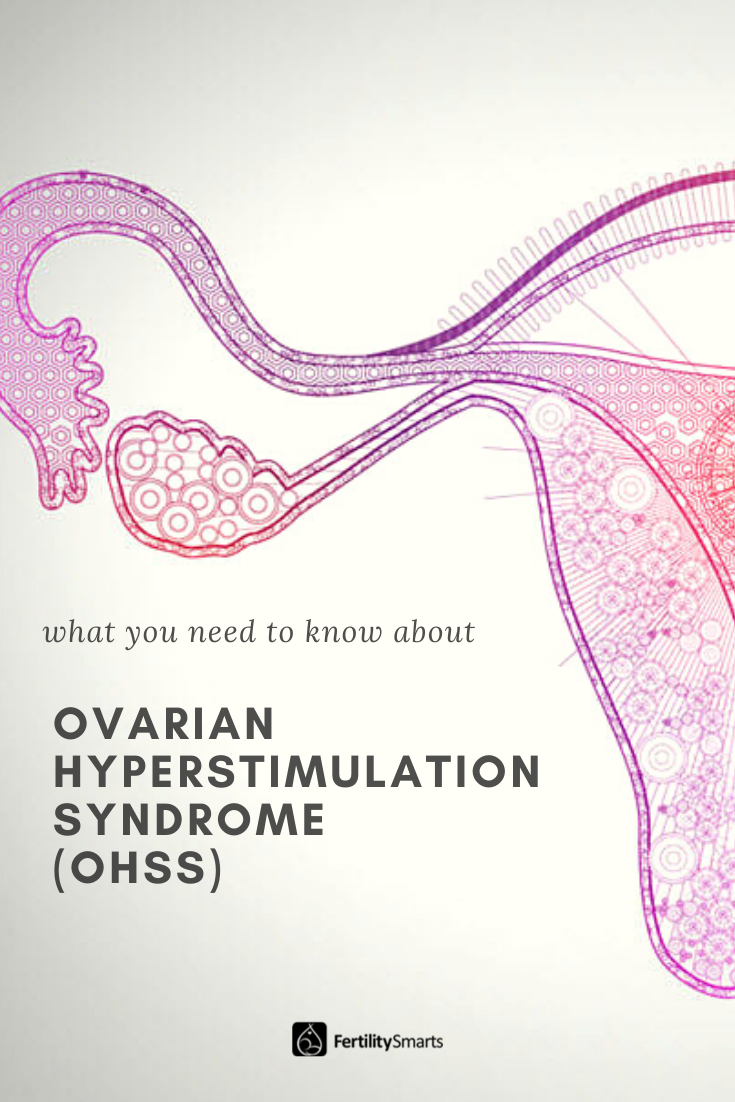Complications from fertility treatments are rare; nevertheless, some people do experience side effects. Anyone undergoing ovarian stimulation either for in vitro fertilization (IVF), egg freezing, or egg donation, is at risk of developing ovarian hyperstimulation syndrome (OHSS), a rare but potentially serious side effect of fertility treatments.
Because of this, It’s to your advantage to be informed and on the lookout for symptoms to bring to your doctor’s attention
What is OHSS?
OHSS is caused by the presence of multiple ovarian cysts in the ovaries that can occur after a robust response to IVF injections.
OHSS is characterized by high levels of vascular endothelial growth factor (VEGF) that gets released after taking the final injection of hCG during IVF.
The sustained, high levels of VEGF, along with estrogen and progesterone, lead to the dilation of blood vessels in the body causing fluid to shift out of the bloodstream and into the abdominal cavity, or in more severe cases, the lung cavity.
Even though a woman with OHSS drinks plenty of fluids, she can become severely dehydrated. As a result, the blood becomes thickened leaving her at risk for blood clots in the legs and lungs.
Related:
What are the Symptoms of OHSS?
The symptoms of OHSS may be mild, moderate, or severe and can be classified as:
- Early-onset. Less than 10 days from retrieval.
- Late-onset. More than 10 days after retrieval, which is usually associated with early pregnancy.
The accumulation of fluid in the abdominal cavity can be very uncomfortable and cause bloating, and sometimes breathlessness. In severe cases, the fluid enters the lungs and causes respiratory distress.
This is why it’s very important to inform your doctor if you have any of the following symptoms:
Mild OHSS
- Mild abdominal distention and discomfort
- Mild nausea/vomiting
- Vomiting
- Diarrhea
- Enlarged ovaries on ultrasounds
Moderate OHSS
All of the signs of mild OHSS plus:
Severe OHSS
All of the signs of mild and moderate OHSS plus:
- Severe abdominal pain
- Persistent nausea and vomiting
- Decreased urinary frequency
- Dark urine
- Shortness of breath
- Tight and enlarged abdomen
- Dizziness
Mild or moderate OHSS usually resolves within a few days unless pregnancy occurs, which may delay recovery.

OHSS & Pregnancy
Because the symptoms of OHSS are exacerbated by pregnancy, sometimes a “freeze all” cycle is the safest option during an IVF cycle. In this case, all the embryos are frozen and a transfer is delayed until full recovery.
Who is at risk?
Some women are more at risk than others of developing this complication. Women with polycystic ovary syndrome (PCOS) are most at risk because they have many tiny follicles present that can respond to the stimulation medicine. Other women at risk are those who have:
- A high number of antral follicles (greater than 24)
- High anti-mullerian hormone (AMH) levels (higher than 3.4 ng/mL)
- High peak estradiol levels during stimulation (higher than 3,500 pg/mL)
- A high number of eggs retrieved (more than 25)
An individual’s risk should be assessed by a doctor ahead of starting an IVF cycle to adjust the starting dose of stimulation medication accordingly.
Additionally, the doctor will do regular ultrasound scans of the ovaries during the stimulation phase and monitor the circulating estrogen levels as they rise.
If the blood estrogen level is rising too high or too quickly, the doctor can reduce the dose of FSH medication or “coast” the treatment by stopping the FSH injections for a few days. This will give the ovaries a break from being over-stimulated and help to reduce the chance of OHSS.
How common is OHSS?
Symptoms of mild OHSS, such as bloating are a common side effect of ovarian stimulation for IVF. The symptoms are easily managed with over-the-counter pain relievers, dietary changes, and increased fluid intake.
Severe OHSS affects around 1 to 5% of cycles and is managed with medical help.
At-Home Treatment of Mild OHSS
Treatment usually involves keeping you comfortable until symptoms subside, which can take approximately 1 to 2 weeks or longer if you are pregnant. Your doctor may also recommend:
- Take over-the-counter pain relievers such as Tylenol.
- Reduce activities — no heavy lifting and straining or strenuous exercise.
- Maintain light activity as total bed rest could increase the risk of certain complications like blood clots.
- Elevate your feet when resting. This helps your body get rid of the extra fluid.
- Avoid sex until you are cleared by your doctor.
- Abstain from alcohol and caffeinated beverages.
- Drink plenty of fluids. Drinks with electrolytes, such as Gatorade or Smart Water, are a good choice.
- Record your weight twice daily and the number of times you urinate.
- Contact your doctor if you note a 5-pound weight gain in 24 hours or a reduction in the frequency of urination by approximately 50%.
- Be aware of bodily changes, and call the doctor with any nausea, pelvic pain, or increasing symptoms.
Clinical Treatment of OHSS
For more severe cases, the following may be required:
- Cancellation of embryo transfer until a later date
- Prescription anti-nausea medication
- Drain excess fluid from the abdomen with a needle puncture, similar to an egg retrieval
- Administer intravenous fluids
How can OHSS be prevented?
Prevention is better than cure, and your doctor should monitor the stimulation phase of the IVF cycle carefully. Ultrasounds and blood tests measure the ovaries’ response to the stimulation drugs.
The dose will be lowered if the estrogen levels become too high or you may take a break from injections for a day or two. It is better to start with a lower dose and add extra FSH during ovarian stimulation than start too high and be at risk for complications.
If the ovarian response is extremely high the doctor might choose to cancel the cycle altogether and start again with a lower dose next time.
Read: IVF Stimulation Protocols
Once a high ovarian response has been detected, a different type of trigger medication may be recommended. Usually, an hCG trigger shot is taken when the follicles are big enough for egg retrieval, but if there is a risk of hyperstimulation the doctor may give you an agonist (Lupron) trigger before the egg collection to induce an LH surge (this can only be done in certain types of stimulation cycles where the patient has not been down-regulated with Lupron before the cycle started).
A lupron trigger will significantly reduce the chance of OHSS but may also reduce the number of eggs retrieved and may hamper the egg maturation process.
A study of all recently published data on OHSS by The Cochrane Collaboration identified the following interventions as having at least a moderate benefit to preventing OHSS:
- Metformin treatment before and during an IVF cycle for women with PCOS.
- Gonadotrophin-releasing hormone (GnRH) antagonist protocols for IVF cycles.
- GnRH agonist trigger for women in which a high number of eggs is expected.
Your doctor should be able to choose the best treatment regimen for you that minimizes the chance of complications while maximizing the treatment outcome.
